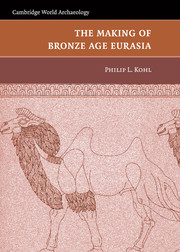Book contents
- Frontmatter
- Contents
- Illustrations and Maps
- Abbreviations
- Preface
- Frontispiece: Eurasian Steppe Zone and the Greater Ancient Near East
- 1 Archaeological Theory and Archaeological Evidence
- 2 The Chalcolithic Prelude – From Social Hierarchies and Giant Settlements to the Emergence of Mobile Economies, ca. 4500–3500 BC
- 3 The Caucasus – Donor and Recipient of Materials, Technologies, and Peoples to and from the Ancient Near East
- 4 Taming the Steppe – The Development of Mobile Economies: From Cattle Herders with Wagons to Horseback Riders Tending Mixed Herds; the Continued Eastward Expansion of Large-Scale Metallurgical Production and Exchange
- 5 Entering a Sown World of Irrigation Agriculture – From the Steppes to Central Asia and Beyond: Processes of Movement, Assimilation, and Transformation into the “Civilized” World East of Sumer
- 6 The Circulation of Peoples and Materials – Evolution, Devolution, and Recurrent Social Formations on the Eurasian Steppes and in West Asia: Patterns and Processes of Interconnection during Later Prehistory
- Appendix
- References
- Index
4 - Taming the Steppe – The Development of Mobile Economies: From Cattle Herders with Wagons to Horseback Riders Tending Mixed Herds; the Continued Eastward Expansion of Large-Scale Metallurgical Production and Exchange
Published online by Cambridge University Press: 05 June 2012
- Frontmatter
- Contents
- Illustrations and Maps
- Abbreviations
- Preface
- Frontispiece: Eurasian Steppe Zone and the Greater Ancient Near East
- 1 Archaeological Theory and Archaeological Evidence
- 2 The Chalcolithic Prelude – From Social Hierarchies and Giant Settlements to the Emergence of Mobile Economies, ca. 4500–3500 BC
- 3 The Caucasus – Donor and Recipient of Materials, Technologies, and Peoples to and from the Ancient Near East
- 4 Taming the Steppe – The Development of Mobile Economies: From Cattle Herders with Wagons to Horseback Riders Tending Mixed Herds; the Continued Eastward Expansion of Large-Scale Metallurgical Production and Exchange
- 5 Entering a Sown World of Irrigation Agriculture – From the Steppes to Central Asia and Beyond: Processes of Movement, Assimilation, and Transformation into the “Civilized” World East of Sumer
- 6 The Circulation of Peoples and Materials – Evolution, Devolution, and Recurrent Social Formations on the Eurasian Steppes and in West Asia: Patterns and Processes of Interconnection during Later Prehistory
- Appendix
- References
- Index
Summary
Although many present-day situations constitute valid analogues of earlier ones, it is possible that certain living strategies existed in the past for which no equivalent appears at present or for which modern equivalent may actually prove to be poor analogues.
(Morales Muniz and Antipina 2003: 331)Broadly defined, the Eurasian steppe consists of the belt of open grasslands stretching latitudinally from Hungary in the west to Manchuria in the east, the largest expanse of such open grasslands in the world (Frontispiece). Our geographical horizons necessarily are more restricted, and our concern is principally to trace late prehistoric developments across the western Eurasian steppe, or the belt extending north of the Black Sea (Pontic steppe) from the mouth of the Danube east across the South Russian steppe beyond the Lower and Middle Volga to the southern trans-Urals region bordering western Siberia and Kazakhstan. Throughout this area, the open grasslands of the steppe proper are sandwiched between the more wooded boreal and broad-leafed forest and then forest-steppe belts to the north and the highland zones of the Caucasus and the Anatolian and Iranian plateaus west and south of the Caspian Sea, and the Central Asian Kyzyl Kum and Kara Kum deserts east of the Caspian. These latitudinal bands can be further subdivided north to south into distinct vegetation zones consisting of forest, forest-steppe, steppe, desert-steppe, and Artemisia and sandy desert zones (Hiebert 2000: 52–53; Figs. 4.1 and 4.2).
- Type
- Chapter
- Information
- The Making of Bronze Age Eurasia , pp. 126 - 181Publisher: Cambridge University PressPrint publication year: 2007



